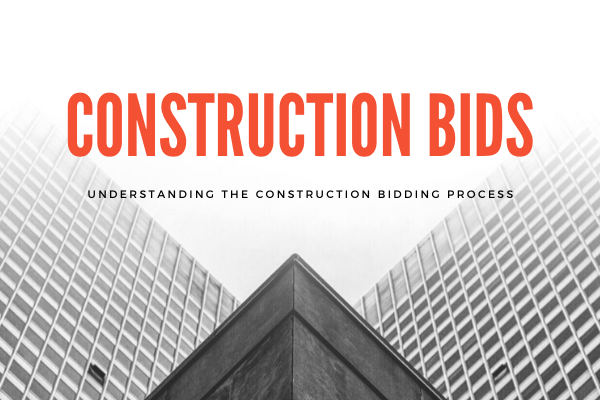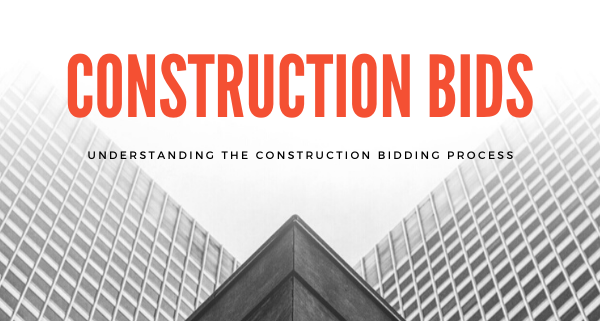Understanding the Construction Bidding Process
New clients frequently have questions about the construction bidding process. How does the bidding process work? Will the contractors’ bids include the amount of time to complete my project? How do we compare bids? They’re all good questions!
Let’s begin with the basics: A bid is a general contractor’s proposal to build the owner’s project. The bid includes the amount of money and time the contractor requires to complete the project. The general contractor uses the architect’s drawings and specifications as the basis of their bid.

9 Basic Steps in the Construction Bidding Process
- The architect works with the owner to design their project.
- The architect prepares construction drawings and specifications (the contract documents).
- The architect solicits interest from qualified general contractors.
- The architect shares contract documents with interested qualified general contractors.
- General contractors solicit bids from their sub-contractors.
- General contractors submit their bids (price and timeframe) to the architect.
- The owner and architect evaluate and compare the bids before selecting the successful bidder.
- The owner and general contractor sign a contract to begin the construction work.
- The architect continues to represent the owner during the project construction phase.
How the Construction Bidding Process Works
The role of an architect is to translate the client’s/owner’s goals into a building design. In addition, the architect represents the project owner during the bidding and construction phases of the project. The general contractor uses the architect’s documents to bid on the project and as a guide for building it.
As the project owner, you want to find the best qualified general contractor to build your project. You also want it completed in an efficient period of time for a reasonable cost. The bidding process helps you to achieve these goals. Here’s how:
Once the contract documents have been finalized, they are shared with qualified general contractors for bidding purposes. General contractors look at the documents and do take-offs for construction materials, project scope, site access, location, etc. They solicit prices from their sub-contractors to determine how much it will cost them in time and money to do the work. Typically, the majority of trades are subbed-out and they may include carpentry, electrical, mechanical, plumbing, roofing, insulation, lightning protection, excavation, and more. There’s a lot involved in creating a bid for your project!
Once general contractors submit their bids, we work with you to compare the bids. Total cost and timeframe are the most important information included in each bid. But the owner and architect may also take other factors into consideration when evaluating bids. The lowest price is not always the best value. For example, we consider the amount of time the contractor has been in business and their insurance qualifications. We consider the general contractor’s experience in doing this type of project.
Once you award the project to a general contractor, changes to the drawings and specifications will have cost and time implications. We review and approve change orders and the associated cost and time are added or subtracted from the contract.
Changes in the Construction Bidding Process
Has it been a while since you built something? If so, the bidding process has changed! The key changes relate to the availability of digital media.
In the past, we hand drew our drawings and typed our specifications on sheets of paper and mylar. When it was time to get bids for the client’s project, we would take these specifications and drawings to a blueprint shop and they would print copies of the documents. The client paid to print the bid sets and it was not uncommon to spend $2,000 on printing documents for a large project.
After they were printed, we distributed them to general contractors after they paid a deposit. Back then, it was common to have contractors in and out of our office. Once the bidding period was over, contractors returned the documents to our office in good condition to receive their deposit check back. These printed documents were then given to the successful bidder for their use during the project’s construction.
Today, we create our documents online using computers. The documents are stored on our server. When the client is ready to send the project out for bid, we share a link to the documents on our server. The bidders can view the drawings and specifications online and their sub-contractors can do so as well. If they want, they can also print the documents.
Advantages of Digital Documents
There are several advantages to using digital documents during the bidding process:
- Everyone has easy access to the current contract documents.
- Every sub-contractor has access to the entire set of documents so they are more informed. In the past, sometimes the general contractor would pull a set of documents apart to share with the various sub-contractor trades and the documents were incomplete.
- Changes to the documents during the bidding period can be made and shared quickly.
- There is no need to print the documents, saving the client time and money.
Feel free to call us with any questions about the construction bidding process.



